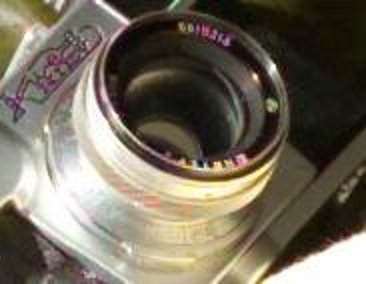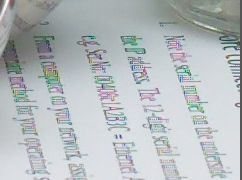| View previous topic :: View next topic |
| Author |
Message |
kansalliskala


Joined: 19 Jul 2007
Posts: 5039
Location: Southern Finland countryside
Expire: 2016-12-30
|
 Posted: Thu Mar 11, 2010 8:33 am Post subject: Rainbow Nameplate Jupiter 8 Posted: Thu Mar 11, 2010 8:33 am Post subject: Rainbow Nameplate Jupiter 8 |
 |
|
kansalliskala wrote:

No I didn't color it myself, that was combined effort of my Kodak and Sigma 50/2.8 AF Macro (which is otherwise very very good lens).
Does someone know what the proper name of this phenomenon is?
(Ok - "Kodak" is not the right answer  ) )
EDIT: I changed the title, don't want anyone to get offended .. this started as joke but came to be a good thread anyways. This is why I like this forum.
_________________
MF: Kodak DCS SLR/c; Samsung NX10; OM-10; Canon T50
Zuiko 28/3.5, Distagon 35/2.8; Yashica ML 50/2;
Zuiko 50/1.4; S-M-C 120/2.8; Zuiko 135/3.5; 200/5;
Tamron AD1 135/2.8, Soligor 180/3.5; Tamron AD1 300/5.6
Tamron zooms: 01A, Z-210
Yashicaflex C; Київ 4 + Юпитер 8, 11; Polaroid 100; Olympus XA; Yashica T3
Museum stuff: Certo-Phot; Tele-Edixon 135; Polaris 90-190; Asahi Bellows; Ixus IIs
Projects: Agfa Isolette III (no shutter), Canon AE-1D (no sensor),
Nikon D80 (dead), The "Peace Camera"
AF: Canon, Tokina, Sigma Video: JVC GZ-MG275E
Last edited by kansalliskala on Thu Mar 11, 2010 10:33 am; edited 1 time in total |
|
| Back to top |
|
 |
Spotmatic


Joined: 18 Aug 2008
Posts: 4045
Location: Netherlands
|
 Posted: Thu Mar 11, 2010 8:52 am Post subject: Posted: Thu Mar 11, 2010 8:52 am Post subject: |
 |
|
Spotmatic wrote:
It's lateral chromatic aberration, seen around high-contrast transitions.
_________________
Peter - Moderator
Pentax K-5 + Pentax 645 + Canon 5D + Bessa RF 10,5cm Heliar, and a 'little' bag full of MF lenses. The lens list is * here *.
My fast 80s: Asahi-Kogaku Takumar 83mm f/1.9 - Super-Takumar 85mm f/1.9 - FA 77mm f/1.8 Limited - Cyclop 85/1.5 (Helios-40 innards) - Komura 80mm f/1.8 - Meyer Görlitz Primoplan 7,5cm 1:1.9 - Carl Zeiss Jena 80mm f/1.8 Pancolar - Canon 85mm f/1.8 S.S.C. - Canon 85mm f/1.2 S.S.C. Aspherical |
|
| Back to top |
|
 |
kansalliskala


Joined: 19 Jul 2007
Posts: 5039
Location: Southern Finland countryside
Expire: 2016-12-30
|
 Posted: Thu Mar 11, 2010 9:25 am Post subject: Posted: Thu Mar 11, 2010 9:25 am Post subject: |
 |
|
kansalliskala wrote:
It is in the center of the picture .. 
Is this the same phenomenon? I saw once the name of it but can't find it again:

_________________
MF: Kodak DCS SLR/c; Samsung NX10; OM-10; Canon T50
Zuiko 28/3.5, Distagon 35/2.8; Yashica ML 50/2;
Zuiko 50/1.4; S-M-C 120/2.8; Zuiko 135/3.5; 200/5;
Tamron AD1 135/2.8, Soligor 180/3.5; Tamron AD1 300/5.6
Tamron zooms: 01A, Z-210
Yashicaflex C; Київ 4 + Юпитер 8, 11; Polaroid 100; Olympus XA; Yashica T3
Museum stuff: Certo-Phot; Tele-Edixon 135; Polaris 90-190; Asahi Bellows; Ixus IIs
Projects: Agfa Isolette III (no shutter), Canon AE-1D (no sensor),
Nikon D80 (dead), The "Peace Camera"
AF: Canon, Tokina, Sigma Video: JVC GZ-MG275E |
|
| Back to top |
|
 |
Spotmatic


Joined: 18 Aug 2008
Posts: 4045
Location: Netherlands
|
 Posted: Thu Mar 11, 2010 9:44 am Post subject: Posted: Thu Mar 11, 2010 9:44 am Post subject: |
 |
|
Spotmatic wrote:
Yes, it is the same. A good read about the subject: http://toothwalker.org/optics/chromatic.html
_________________
Peter - Moderator
Pentax K-5 + Pentax 645 + Canon 5D + Bessa RF 10,5cm Heliar, and a 'little' bag full of MF lenses. The lens list is * here *.
My fast 80s: Asahi-Kogaku Takumar 83mm f/1.9 - Super-Takumar 85mm f/1.9 - FA 77mm f/1.8 Limited - Cyclop 85/1.5 (Helios-40 innards) - Komura 80mm f/1.8 - Meyer Görlitz Primoplan 7,5cm 1:1.9 - Carl Zeiss Jena 80mm f/1.8 Pancolar - Canon 85mm f/1.8 S.S.C. - Canon 85mm f/1.2 S.S.C. Aspherical |
|
| Back to top |
|
 |
no-X


Joined: 19 Jul 2008
Posts: 2495
Location: Budejky, Czech Republic
|
 Posted: Thu Mar 11, 2010 10:20 am Post subject: Posted: Thu Mar 11, 2010 10:20 am Post subject: |
 |
|
no-X wrote:
Spotmatic: In this situation I can't agree fully. Maybe there is some chromatic aberration, but 90% of this "effect" is created by the Kodak body.
Let me explain:
Kodak (and almost all digital cameras) use bayer sensor, which captures only one color channel per pixel (red or blue or green). If the sensor captures per-pixel details and esp. details in black&white, problem is on the way. Originally color-neutral (BW) data is captured as chromatic data (as red, or blue, or green).
Canon, Nikon, Pentax, Olympus, Sony, Panasonic... use optical "correction" - so called low pass filter, which is placed in front of the bayer sensor (the low-pass filter blurs per-pixel data to prevent capturing of per-pixel details, which would change into color mess - in camera processor then applies some sharpening to make the image look sharp).
Leica doesn't use low-pass filter - they use special software processing to avoid this problem.
Kodak doesn't use low-pass filter, but (at least their older camera models) don't use any software correction.
Here is 1:1 example of this Kodak phenomenon on black/white situation:

Some time ago I posted here this simulated example:
Example of bayer-based camera system without low-pass filter:

A: real image
B: image taken by bayer sensor (what can the camera "see")
C: image processed (debayering) by the camera - quite sharp, but color artifacts are present
Example of bayer-based camera system with low-pass filter:

A: real image
B: what does the low-pass filter do (fine details are removed as prevention of artifacting)
C: image taken by bayer sensor (what can the camera "see")
D: image processed by the camera (debayering)
E: final processing (sharpening)
image lost some detail, but artifacts aren't there
_________________
(almost) complete list of Helios lenses |
|
| Back to top |
|
 |
kansalliskala


Joined: 19 Jul 2007
Posts: 5039
Location: Southern Finland countryside
Expire: 2016-12-30
|
 Posted: Thu Mar 11, 2010 10:30 am Post subject: Posted: Thu Mar 11, 2010 10:30 am Post subject: |
 |
|
kansalliskala wrote:
Thank you No-X, this is actually very good news for me!
Now I just need to hack some software .. 
It is way easier than hacking the sensor.
_________________
MF: Kodak DCS SLR/c; Samsung NX10; OM-10; Canon T50
Zuiko 28/3.5, Distagon 35/2.8; Yashica ML 50/2;
Zuiko 50/1.4; S-M-C 120/2.8; Zuiko 135/3.5; 200/5;
Tamron AD1 135/2.8, Soligor 180/3.5; Tamron AD1 300/5.6
Tamron zooms: 01A, Z-210
Yashicaflex C; Київ 4 + Юпитер 8, 11; Polaroid 100; Olympus XA; Yashica T3
Museum stuff: Certo-Phot; Tele-Edixon 135; Polaris 90-190; Asahi Bellows; Ixus IIs
Projects: Agfa Isolette III (no shutter), Canon AE-1D (no sensor),
Nikon D80 (dead), The "Peace Camera"
AF: Canon, Tokina, Sigma Video: JVC GZ-MG275E |
|
| Back to top |
|
 |
kansalliskala


Joined: 19 Jul 2007
Posts: 5039
Location: Southern Finland countryside
Expire: 2016-12-30
|
 Posted: Thu Mar 11, 2010 11:21 am Post subject: Posted: Thu Mar 11, 2010 11:21 am Post subject: |
 |
|
kansalliskala wrote:
| no-X wrote: |
Some time ago I posted here this simulated example:
|
Here is an example how it looks in real world.
"Hello world!" is Gimp's 1 pixel pen.
100% crop

800% crop

call it pixel-peeping if you like 
_________________
MF: Kodak DCS SLR/c; Samsung NX10; OM-10; Canon T50
Zuiko 28/3.5, Distagon 35/2.8; Yashica ML 50/2;
Zuiko 50/1.4; S-M-C 120/2.8; Zuiko 135/3.5; 200/5;
Tamron AD1 135/2.8, Soligor 180/3.5; Tamron AD1 300/5.6
Tamron zooms: 01A, Z-210
Yashicaflex C; Київ 4 + Юпитер 8, 11; Polaroid 100; Olympus XA; Yashica T3
Museum stuff: Certo-Phot; Tele-Edixon 135; Polaris 90-190; Asahi Bellows; Ixus IIs
Projects: Agfa Isolette III (no shutter), Canon AE-1D (no sensor),
Nikon D80 (dead), The "Peace Camera"
AF: Canon, Tokina, Sigma Video: JVC GZ-MG275E |
|
| Back to top |
|
 |
Spotmatic


Joined: 18 Aug 2008
Posts: 4045
Location: Netherlands
|
 Posted: Thu Mar 11, 2010 11:30 am Post subject: Posted: Thu Mar 11, 2010 11:30 am Post subject: |
 |
|
Spotmatic wrote:
Excellent work, no-X! Thanks for explaining it so thoroughly.
_________________
Peter - Moderator
Pentax K-5 + Pentax 645 + Canon 5D + Bessa RF 10,5cm Heliar, and a 'little' bag full of MF lenses. The lens list is * here *.
My fast 80s: Asahi-Kogaku Takumar 83mm f/1.9 - Super-Takumar 85mm f/1.9 - FA 77mm f/1.8 Limited - Cyclop 85/1.5 (Helios-40 innards) - Komura 80mm f/1.8 - Meyer Görlitz Primoplan 7,5cm 1:1.9 - Carl Zeiss Jena 80mm f/1.8 Pancolar - Canon 85mm f/1.8 S.S.C. - Canon 85mm f/1.2 S.S.C. Aspherical |
|
| Back to top |
|
 |
LucisPictor


Joined: 26 Feb 2007
Posts: 17633
Location: Oberhessen, Germany / Maidstone ('95-'96)
Expire: 2013-12-03
|
 Posted: Thu Mar 11, 2010 2:07 pm Post subject: Posted: Thu Mar 11, 2010 2:07 pm Post subject: |
 |
|
LucisPictor wrote:
| kansalliskala wrote: |
Thank you No-X, this is actually very good news for me!
Now I just need to hack some software .. 
It is way easier than hacking the sensor. |
I don't know. I guess "hacking" a sensor is easier but also has worse consequences. 
_________________
Personal forum activity on pause every now and again (due to job obligations)!
Carsten, former Moderator 
Things ON SALE
Carsten = "KAPCTEH" = "Karusutenu" | T-shirt?.........................My photos from Emilia: http://www.schouler.net/emilia/emilia2011.html
My gear: http://retrocameracs.wordpress.com/ausrustung/
Old list: http://forum.mflenses.com/viewtopic.php?t=65 (Not up-to-date, sorry!) | http://www.lucispictor.de | http://www.alensaweek.wordpress.com |
http://www.retrocamera.de |
|
| Back to top |
|
 |
kansalliskala


Joined: 19 Jul 2007
Posts: 5039
Location: Southern Finland countryside
Expire: 2016-12-30
|
 Posted: Thu Mar 11, 2010 3:19 pm Post subject: Posted: Thu Mar 11, 2010 3:19 pm Post subject: |
 |
|
kansalliskala wrote:
Actually I already downloaded DCRaw source. Program is not very difficult .. but then I should understand the algorithm also .. 
Or just change something and see if I get b&w or some caleidoscopic effect. 
_________________
MF: Kodak DCS SLR/c; Samsung NX10; OM-10; Canon T50
Zuiko 28/3.5, Distagon 35/2.8; Yashica ML 50/2;
Zuiko 50/1.4; S-M-C 120/2.8; Zuiko 135/3.5; 200/5;
Tamron AD1 135/2.8, Soligor 180/3.5; Tamron AD1 300/5.6
Tamron zooms: 01A, Z-210
Yashicaflex C; Київ 4 + Юпитер 8, 11; Polaroid 100; Olympus XA; Yashica T3
Museum stuff: Certo-Phot; Tele-Edixon 135; Polaris 90-190; Asahi Bellows; Ixus IIs
Projects: Agfa Isolette III (no shutter), Canon AE-1D (no sensor),
Nikon D80 (dead), The "Peace Camera"
AF: Canon, Tokina, Sigma Video: JVC GZ-MG275E |
|
| Back to top |
|
 |
|
|
|
You cannot post new topics in this forum
You cannot reply to topics in this forum
You cannot edit your posts in this forum
You cannot delete your posts in this forum
You cannot vote in polls in this forum
|
